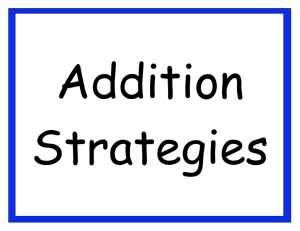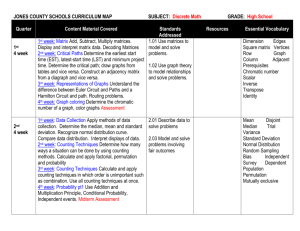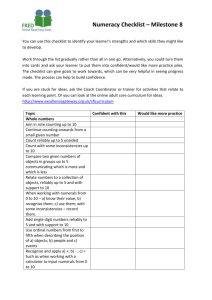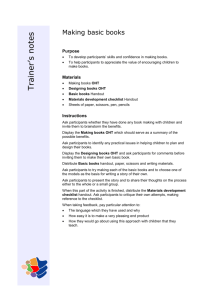Unit 8
advertisement
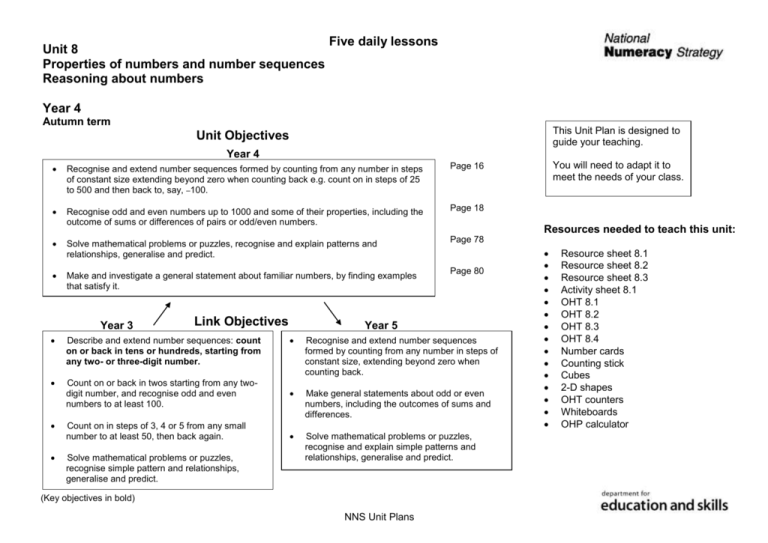
Unit 8 Properties of numbers and number sequences Reasoning about numbers Five daily lessons Year 4 Autumn term This Unit Plan is designed to guide your teaching. Unit Objectives Year 4 Recognise and extend number sequences formed by counting from any number in steps of constant size extending beyond zero when counting back e.g. count on in steps of 25 to 500 and then back to, say, –100. Page 16 Recognise odd and even numbers up to 1000 and some of their properties, including the outcome of sums or differences of pairs or odd/even numbers. Page 18 Solve mathematical problems or puzzles, recognise and explain patterns and relationships, generalise and predict. Page 78 Make and investigate a general statement about familiar numbers, by finding examples that satisfy it. Year 3 Link Objectives Describe and extend number sequences: count on or back in tens or hundreds, starting from any two- or three-digit number. Resources needed to teach this unit: Page 80 Year 5 Recognise and extend number sequences formed by counting from any number in steps of constant size, extending beyond zero when counting back. Count on or back in twos starting from any twodigit number, and recognise odd and even numbers to at least 100. Make general statements about odd or even numbers, including the outcomes of sums and differences. Count on in steps of 3, 4 or 5 from any small number to at least 50, then back again. Solve mathematical problems or puzzles, recognise and explain simple patterns and relationships, generalise and predict. Solve mathematical problems or puzzles, recognise simple pattern and relationships, generalise and predict. (Key objectives in bold) NNS Unit Plans You will need to adapt it to meet the needs of your class. Resource sheet 8.1 Resource sheet 8.2 Resource sheet 8.3 Activity sheet 8.1 OHT 8.1 OHT 8.2 OHT 8.3 OHT 8.4 Number cards Counting stick Cubes 2-D shapes OHT counters Whiteboards OHP calculator Planning sheet Oral and Mental Objectives and Vocabulary To count on or back in 10, 100, 1000 from any whole number up to 10 000. Day One Teaching Activities Prepare number cards from Resource sheet 8.1. +1000 –1000 +10 –10 +100 –100 Unit 8 Properties of numbers and number sequences Reasoning about numbers Main Teaching Objectives and Vocabulary To recognise and extend number sequences formed by counting from any number in steps of constant size. Term: Autumn Year Group: 4 Plenary Teaching Activities Demonstrate with the counting stick counting in steps of 2 starting from a twodigit number. Move on to counting up in steps of 3, 4, 5. Teaching Activities/ Focus Questions Write on the board: 89, 79, 69 Tell the children the start number and the step e.g. start 27 step +3. Ask what the next number is, and what rule they used to get it. Q What would the number at the end of the stick be? Q Will the sequence reach zero? Using an OHP calculator enter a start number and set the constant function to +2, then get the children to say the numbers as you press the equals key. Q What happens after you reach 9? Repeat with +3, +4, +5. Tell the children that they will be counting in steps. Which step will depend on which card you hold up. Children have to say the next number before equals key is pressed. Repeat with –2, –3, –4, –5. Choose a starting number e.g. 43 and hold up Ask questions like: +10 Q What is the next number in the sequence?… and the next? Let the children count up and then show –10 Q So what is the rule for this sequence? card. Give the children these sequences. Working with a partner can they work out the next three numbers? Children count down. (1) (2) (3) (4) (5) Change start number remembering the range stated in the objective. Change the number card. VOCABULARY consecutive sequence RESOURCES Resource sheet 8.1 Ask children to look at this sequence: 17, 20, 23, 26. Extend the activity by selecting the cards randomly. 48, 41, 34, 27 135, 137, 139, 141 268, 266, 264, 262 194, 189, 184, 179 348, 351, 354, 357 Take feedback and discuss answers. VOCABULARY sequence, predict rule increase, decrease Ask the children (still in pairs) to work out the three numbers that come before the first number in each sequence. Discuss answers. RESOURCES Counting stick OHP calculator NNS Unit Plans Reflect on the important points to remember: – compare two numbers to establish the step size; – check with the next number; – in sequences the numbers increase or decrease. Tell the children they will be extending their own number sequences tomorrow. By the end of the lesson children should be able to: Recognise and extend number sequences by counting on and back in any steps. (Refer to supplement of examples, section 6, page 16.) Planning sheet Oral and Mental Objectives and Vocabulary To explain methods and reasoning about numbers and shapes. Day Two Unit 8 Properties of numbers and number sequences Reasoning about numbers Main Teaching Teaching Activities Display OHT 8.1 first statement only. Give pairs of children true/false cards. Allow a short time for pairs to agree whether the statement is true or false. Ask pairs to show the appropriate true/false card and explain their reasoning. Objectives and Vocabulary Recognise and extend number sequences formed by counting from any number in steps of constant size, extending beyond zero when counting back. Term: Autumn Year Group: 4 Plenary Teaching Activities Teaching Activities/ Focus Questions Using the counting stick consolidate the previous day’s lesson, counting up and back in steps of a constant size. Try 3s and 6s, 2s and 4s and 8s, 5s and 10s. Write on the board: □ 50 60 70 □ □ Choose children to supply the missing numbers giving the reason for their choice. Point to the middle of the counting stick and tell the children that this is zero. From zero, counting up in 4s to 20 then back to zero. Ask: Repeat with other sequences e.g. 1 2 □ □ □ Q What is the next number below zero? Repeat for other statements. Make sure children count backwards using negative 4, negative 8 etc. Using an OHP calculator enter 9 – 3. Q Are there other possibilities? □ □ 95 98 □ 104 107 □ □ □ □ □ □ 7 12 □ □ Pressing equals repeatedly will take number down to zero. Ask the children to predict what the next number will be when continuing to press equals. Repeat for –5, –6. Ask the children to make up sequences that: end in 14 end in 10 end in 3 in each case by counting up and also by counting down. Discuss the sequences the children have found. Look out for those including negatives. Get children to write them on the board and explain them. Discuss methods and strategies. Ask the children to devise some sequences that go up, then down, in 6s and 12s, in 8s and 4s. Discuss the sequences and ask the children to explain their methods and strategies. VOCABULARY explain reason VOCABULARY negative RESOURCES OHT 8.1 True/false cards Resource sheet 8.1 Resource sheet 8.2 RESOURCES Counting stick OHP calculator NNS Unit Plans By the end of the lesson the children should be able to: Recognise and extend number sequences by counting on and back in any steps, extending beyond zero when counting back. (Refer to supplement of examples, section 6, page 16.) Planning sheet Oral and Mental Objectives and Vocabulary To classify polygons using criteria such as number of right angles, whether or not they are regular, symmetry properties. Day Three Unit 8 Properties of numbers and number sequences Reasoning about numbers Main Teaching Teaching Activities Show OHT 8.2 Point to two 2-D shapes on the OHP. Ask children questions such as: Q How are these shapes different? Objectives and Vocabulary Recognise odd and even numbers up to 100 and some of their properties. Make and investigate a general statement about familiar numbers by finding examples that satisfy it. Term: Autumn Plenary Teaching Activities Check children’s recognition of odd and even numbers as follows: Ask them to write any 3 odd numbers on a whiteboard/paper and to hold them up for you to see. Jot down on class board a selection from what you see (include some singledigit, and two- and three- digit numbers). Ask for a definition of an odd number. (If children are hesitant, get them to think about why e.g. 2 is NOT ODD). Q How are they the same? – drawing out criteria as in the objective. Draw a box on board and put title ‘Statements about odd numbers’. Jot down the definitions the children have given. Repeat with other pairs of shapes. Year Group: 4 Teaching Activities/ Focus Questions Take feedback. Add statements to the boxes. See if anyone can suggest why a statement such as 0 + 0 = E might be true. Model using children or practical materials such as cubes. Q How do you know that this could not be true? Repeat the process for even numbers. Say you want to see if there are other statements you could make about odd or even numbers to add to the boxes. Have Resource sheet 8.3 for suggestions you could make for investigation. Give children time to investigate and write examples in their books. I bought a lolly for 26p and a drink for 32p. I paid 57p. Make up other examples in which the children need to draw on what they have found for explanation. By the end of the lesson children should be able to: Recognise odd and even numbers and some of their properties; Make and investigate a general statement about familiar numbers by finding examples that satisfy it. (Refer to supplement of examples, section 6, pages 18, 80.) VOCABULARY right angles, symmetry, regular, irregular RESOURCES 2-D shapes OHT 8.2 RESOURCES Whiteboards Cubes Resource sheet 8.3 NNS Unit Plans Planning sheet Oral and Mental Objectives and Vocabulary To know by heart multiplication facts for 2, 3, 4, 5 and 10 times tables. Day Four Unit 8 Properties of numbers and number sequences Reasoning about numbers Main Teaching Teaching Activities Objectives and Vocabulary Solve mathematical problems or puzzles. Show OHT 8.3 9 24 30 7 6 4 10 2 12 22 16 28 8 40 15 18 21 25 50 20 25 3 60 35 14 Term: Autumn Year Group: 4 Plenary Teaching Activities Teaching Activities/ Focus Questions Use number cards from range 2-6. Recap meaning of the word ‘consecutive’. Child chooses card e.g. 3, from pile. Stick on board/write on OHT Recognise and explain patterns and relationships, generalise and predict. 2 Use counters (OHT). 3 Write on the board sets of three consecutive numbers 4 Write number before, number after. e.g. 24, 25, 26. Generate five sets of numbers and ask: Find total. Q What about 240, 250, 260? Q What do we call these sets of numbers? Cover 3 numbers in the 4 times table. Use other examples e.g. 36, 42 and then extend to 333, 666 if you can. Explain that we call these consecutive numbers. Choose children to say multiplication fact for their number. e.g. 4 x 3 = 12 12 Use Activity sheet 8.1. 1 Remove counters. 2 3 4 5 6 7 8 9 10 11 12 Ask children to work in pairs to find sets of consecutive numbers which give totals – Repeat with other multiplication tables. up to 20 up to 30 more than 30 less than 10. 3 numbers in 5 times table, 10 times table etc. Cover all the numbers in 4 times table. Cover all numbers in 5 times table etc. Discuss methods used to find total. Pull out the relationship through questioning. (Some children may see that the total is 3 times the middle number.) Bring out related facts: 15 in 3s and 5s, and relationship between 2s and 4s. HOMEWORK – Take the sheet home and investigate five consecutive numbers. Explain how you can work out the answer to someone in your home. By the end of the lesson children should be able to: Tackle number problems in a systematic manner; Recognise simple patterns; Generalise and predict. (Refer to supplement of examples, section 6, page 78.) VOCABULARY consecutive RESOURCES OHT 8.3 OHT counters RESOURCES Number cards Activity sheet 8.1 NNS Unit Plans Planning sheet Oral and Mental Objectives and Vocabulary To know by heart multiplication facts for 2, 3, 4, 5 and 10 times tables. Derive quickly division facts for 2, 3, 4, 5 and 10 times tables. Day Five Unit 8 Properties of numbers and number sequences Reasoning about numbers Main Teaching Teaching Activities Objectives and Vocabulary Show the children these numbers or write them on the board: 2 28 8 7 4 15 20 6 32 3 50 18 30 10 Solve mathematical problems or puzzles, recognise and explain patterns and relationships, generalise and predict. Term: Autumn Plenary Teaching Activities Year Group: 4 Set an investigation as follows: A garden pond is to be surrounded by paving stones. Use OHT 8.4 to show: Teaching Activities/ Focus Questions Begin by pulling out the numbers: 1 pond needs 8 stones 2 ponds need 10 stones etc. Discuss ways in which children have recorded: pictures numbers placed randomly tabulation etc. 5 24 12 Give the children two minutes to talk to their partner about multiplication and division facts using these numbers. Q How many stones do we need? Q How many stones would you need to surround two ponds? Take feedback from the children. Use OHT 8.5 to show: Discuss efficiency of the different ways of recording. Start to predict: ask children how many stones might be needed for 10 ponds etc. Look at how far can you reasonably take the prediction. Q How many stones do we need? Instruct the children to work in pairs and investigate how many stones they would need to surround 3, 4 or 5 ponds. By the end of the lesson children should be able to: Tell them that they can record in any way they like. Tackle number problems in a systematic manner; Give them time to investigate, noting and encouraging by questioning those who can’t get started. Recognise simple patterns; Do not direct children but observe and question. Generalise and predict. (Refer to supplement of examples, section 6, page 78.) RESOURCES OHT 8.4 OHT 8.5 NNS Unit Plans

